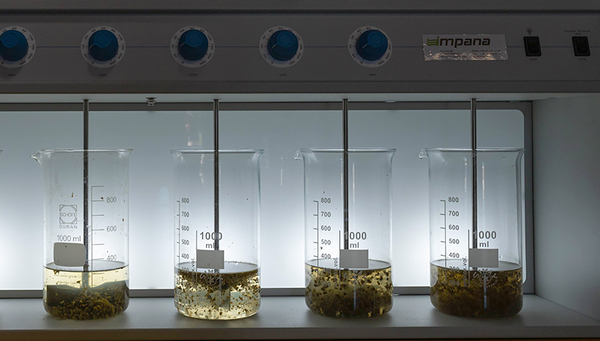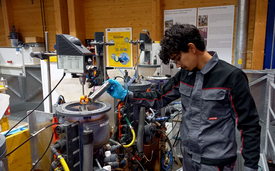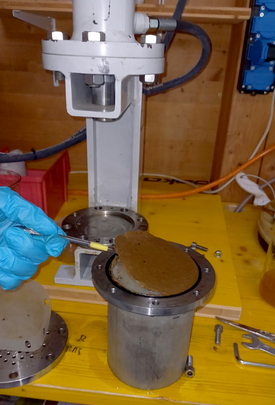Archive detail
Recovering energy from faeces
April 12, 2022 |
The difference couldn’t be starker: In Switzerland, 97 per cent of households are connected to central wastewater treatment plants, whereas three billion people worldwide have no connection to a sewage system at all – predominantly in low-income countries.
Understandably, these two very different realities call for different solutions when it comes to sewage disposal. For a long time, Eawag has been carrying out research into how sanitation provision can be improved around the world – partly by means of appropriate treatment of faecal sludge, which can be used as a fuel once it has been dried. The insights gained in Africa, for example, are soon to be applied in Switzerland: “We want to make the knowledge gained over decades of research available for use all over the world,” says Michael Vogel from Eawag's Department of Sanitation, Water and Solid Waste for Development. “We’re working together to achieve global solutions.”
Solid fuels for industry
Solutions of this kind are of interest in the context of a “sanitation and nutrient transition”, which includes efforts to optimise the recovery of resources from wastewater in high-income countries. Led by Linda Strande, the Eawag research group Management of Excreta, Wastewater and Sludge (MEWS) has carried out studies and pilot projects in several African countries with technologies for producing solid fuels from faeces. In this context, the wide variations in the characteristics of faecal sludge represent a considerable challenge, but there are also pivotal questions around how the sludge can be dewatered, how much energy and space this requires, and what kind of market ultimately exists for these faecal fuels. As became apparent in Uganda and Senegal, there may be significant potential for their use in industry. For example, there is consistently high demand for fuels for the operation of brick kilns – and with industrial applications, the issue of potential pathogen transmission from faecal fuels does not arise.
Here in Switzerland, the concept of using black water directly at source is still in its infancy. “Research into the necessary technologies has only recently begun in Switzerland,” says Michael Vogel, Scientific Collaborator in the MEWS research group. One significant contender is the idea of dividing the wastewater into three components – urine, black water (flush water with faeces) and grey water (slightly dirty water from showers etc.) – and treating it in decentralised facilities.
Vogel has a process in mind for dewatering black water directly in basements, as well as logistical solutions to enable the further use of solids at a district level. It may even make sense to combine centralised and decentralised systems, using certain components directly in situ for the recovery of energy and nutrients while feeding the residual water into the sewage system. “This issue requires a localised as well as holistic approach,” says Vogel. “Some of the factors to consider include costs, greenhouse gas emissions and existing infrastructure, as well as the capacity available at the central wastewater treatment plant.”
Dewatering: Sensors for the correct metering of flocculants
In Switzerland, just as in low-income countries, the sheer variability of black water poses a major problem for its processing – after all, every trip to the toilet delivers different starting materials and quantities. Research at Eawag focuses on precisely these sorts of challenges.
For instance, studies have been carried out in relation to Switzerland to determine which flocculants are best suited to accelerating the dewatering of black water, with researchers paying particular attention to organic matter (polymers). Moreover, one project currently underway aims to clarify what quantities of flocculants are required in what situations in order to achieve optimum results. The objective is to compare various sensor types for determining the quantity of solids in black water. Ascertaining precise information about the nature of the sludge paves the way for process automation. In a follow-up step, the ultimate aim will be to clarify which existing presses – including those used in the foodstuffs industry – are best suited to the production of pellets from the dried sludge.
Test using optical sensors for determining the quantity of solid matter in black water samples.
(Photo: Michael Vogel, Eawag)
Compaction tests investigate the extent to which black water can be dewatered. After compaction, it has a solids content of around 25 per cent.
(Photo: Michael Vogel, Eawag)
Here, too, there are some fundamental challenges to overcome. In order for the pellets to be used efficiently for energy recovery, they must consist of approximately 90 per cent solid matter. However, this cannot be achieved using presses alone – in other words, the pellets must also be dried.
Production of biogas, compost or animal feed from faeces
There are, however, other ways of putting black water to use. In the production of biogas, for example, the moisture content can be higher than in the case of pellets. Another possibility is pyrolysis, which not only produces carbon but also combustible gases. That being said, all of these technologies offer only limited potential for energy production: “At district level, wastewater can be processed in order to recover energy that, although it doesn’t come close to meeting a household's energy requirements, can perhaps make a contribution to cooking or heating,” says Vogel.
However, the energy contained in the faeces can also be used in a very different way: namely as a component of compost in order to improve soil, or as a basis for the production of animal feed. The larvae of soldier flies, for example, eat the solid constituents of black water and thereby convert them into insect biomass. Nevertheless, before wastewater can be widely used as a resource in Switzerland, there are more than just technical problems to be overcome. So far, legal regulations are only in place for the use of sewage sludge from wastewater treatment plants, stipulating that they cannot be spread on fields as fertiliser and must instead be dried and then burned at waste incineration plants or cement works. In the future, however, Michael Vogel believes it will also be possible to recycle black water from households: “Our task as researchers is to show industry that solutions are feasible and that a market exists for them.”
Cover picture: The beaker test is used to determine which flocculants are best suited to dewatering the black water. (Photo: Linda Strande, Eawag)
Funding / Cooperations
- Eawag
- SNF



